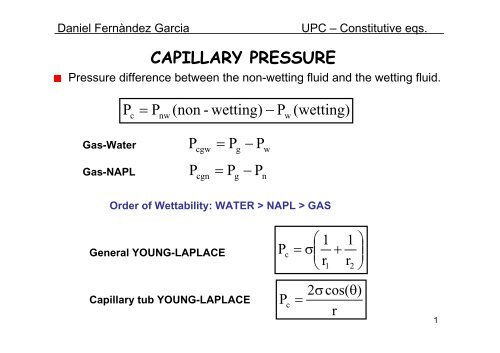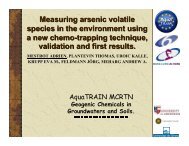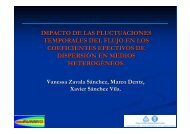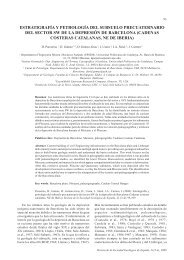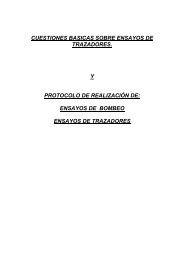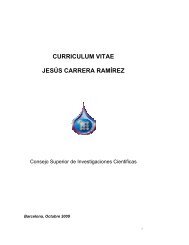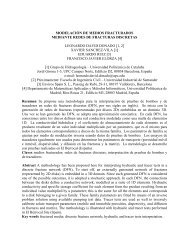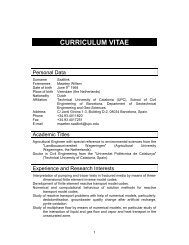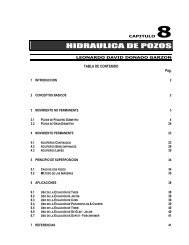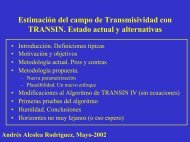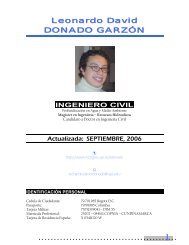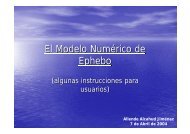CAPILLARY PRESSURE - UPC
CAPILLARY PRESSURE - UPC
CAPILLARY PRESSURE - UPC
Create successful ePaper yourself
Turn your PDF publications into a flip-book with our unique Google optimized e-Paper software.
Daniel Fernàndez Garcia<br />
<strong>UPC</strong> – Constitutive eqs.<br />
<strong>CAPILLARY</strong> <strong>PRESSURE</strong><br />
Pressure difference between the non-wetting fluid and the wetting fluid.<br />
P<br />
c<br />
=<br />
P<br />
nw<br />
(non -<br />
wetting)<br />
−<br />
P<br />
w<br />
(wetting)<br />
Gas-Water<br />
P<br />
cgw<br />
=<br />
P<br />
g<br />
−<br />
P<br />
w<br />
Gas-NAPL<br />
P<br />
cgn<br />
=<br />
P<br />
g<br />
−<br />
P<br />
n<br />
Order of Wettability: WATER > NAPL > GAS<br />
General YOUNG-LAPLACE<br />
P<br />
c<br />
⎛<br />
= σ<br />
⎜<br />
⎝<br />
1<br />
r<br />
1<br />
+<br />
1<br />
r<br />
2<br />
⎞<br />
⎟<br />
⎠<br />
Capillary tub YOUNG-LAPLACE<br />
P c<br />
=<br />
2σcos(<br />
θ)<br />
r<br />
1
Daniel Fernàndez Garcia<br />
<strong>UPC</strong> – Constitutive eqs.<br />
<strong>CAPILLARY</strong> <strong>PRESSURE</strong><br />
A decrease of the meniscus radii corresponds to an increase of the capillary pressure.<br />
If a water-saturated soil is drained , the wetting phase retreats to smaller pores<br />
An increase of the meniscus radii corresponds to a decrease of the capillary pressure<br />
If imbibition occurs, the wetting phase penetrates into larger pores<br />
P c2<br />
< P c1<br />
R 2<br />
> R 1<br />
2
Daniel Fernàndez Garcia<br />
<strong>UPC</strong> – Constitutive eqs.<br />
<strong>CAPILLARY</strong> <strong>PRESSURE</strong> - SATURATION<br />
If we replace the meniscus radii by the pore radius, it becomes clear that<br />
an increase of the saturation of the non-wetting phase must also lead to<br />
an increase of the capillary pressure<br />
P<br />
c<br />
⎛<br />
= σ<br />
⎜<br />
⎝<br />
1<br />
r<br />
1<br />
+<br />
1<br />
r<br />
2<br />
⎞<br />
⎟<br />
⎠<br />
P c<br />
=<br />
2σcos(<br />
θ)<br />
r<br />
The relationship between the capillary pressure and saturation is known<br />
as the retention curve<br />
P<br />
cgw<br />
=<br />
P<br />
cgw<br />
(S<br />
w<br />
,S<br />
g<br />
)<br />
3
Daniel Fernàndez Garcia<br />
<strong>UPC</strong> – Constitutive eqs.<br />
TYPICAL RETENTION CURVES<br />
The shape of the retention curve depends on the material<br />
4
Daniel Fernàndez Garcia<br />
<strong>UPC</strong> – Constitutive eqs.<br />
HISTERESIS<br />
The relationship for p c (S w ) depends on the pressure (or saturation) history.<br />
Different relationship for drainage and imbibition<br />
5
Daniel Fernàndez Garcia<br />
a) Geometry of pores<br />
HISTERESIS<br />
<strong>UPC</strong> – Constitutive eqs.<br />
b) Contact angle depends on the process (drainage or imbibition)<br />
c) Trapped air reduces the amount of water available<br />
d) Others: swelling of soil.<br />
6
Daniel Fernàndez Garcia<br />
<strong>UPC</strong> – Constitutive eqs.<br />
RETENTION CURVES<br />
HISTERESIS<br />
Medium sand<br />
Fine sand<br />
7
Daniel Fernàndez Garcia<br />
<strong>UPC</strong> – Constitutive eqs.<br />
PUNTS DE LA CORBA DE RETENCIÓ<br />
Punt de marciment (θ w<br />
): θ en que les plantes no poden extreure l’aigua del subsòl. Les forces de<br />
succió de les plantes és més petita que les forces de retenció del terreny<br />
Capacitat de camp (θ f<br />
): θ després de drenar l’aigua gravífica. Representa l’aigua que, després de<br />
tres dies de ploure o regar, es queda en el terreny<br />
Capacitat de retenció (∆θ p<br />
⇒ θ f<br />
- θ w<br />
): θ disponible per les plantes<br />
Porositat drenable (S y<br />
= φ - θ f<br />
)<br />
Pressió d’entrada (Pd)<br />
Contingut volumètric residual (θ r<br />
)<br />
P c<br />
θ r<br />
∆θ p S y<br />
P d<br />
θ →<br />
θ w φ<br />
θ f<br />
8
Daniel Fernàndez Garcia<br />
RETENTION CURVE MODELS<br />
<strong>UPC</strong> – Constitutive eqs.<br />
Brooks and Corey (1964)<br />
S −S ⎛p<br />
⎞<br />
S (p ) = = if p ≥p<br />
− ⎝ ⎠<br />
w wr d<br />
e c ⎜ ⎟<br />
c d<br />
Sm Swr pc<br />
S −S<br />
S (p ) = = 1 if p < p<br />
w wr<br />
e c c d<br />
Sm<br />
−Swr<br />
Van Genutchen (1980)<br />
S −S<br />
S (p ) = = 1 + ( α⋅ p ) if p > 0<br />
λ<br />
n<br />
−<br />
( ) m<br />
w wr<br />
e c c c<br />
Sm<br />
−Swr<br />
S<br />
λ : pore -size index → values between 0.3 and 3<br />
p<br />
wr<br />
d<br />
: residual water saturation<br />
: air entry pressure<br />
α: constant<br />
n: constant<br />
m:constant<br />
Physical meaning:<br />
λ : slope → granulometry<br />
p : related to the largest pores<br />
d<br />
α:<br />
interfacial properties of the fluids<br />
9
Daniel Fernàndez Garcia<br />
<strong>UPC</strong> – Constitutive eqs.<br />
EFFECTIVE SATURATION<br />
S(p)<br />
e<br />
c<br />
=<br />
S<br />
S<br />
w<br />
m<br />
− S<br />
− S<br />
wr<br />
wr<br />
S m<br />
= 1 when DNAPL is invading into a<br />
water saturated porous medium<br />
S m<br />
< 1 when water displaces DNAPL<br />
because of the entrapment of DNAPL<br />
s m<br />
s m : Maximum wetting phase saturation<br />
10
Daniel Fernàndez Garcia<br />
RETENTION CURVE MODELS<br />
<strong>UPC</strong> – Constitutive eqs.<br />
Correlation of Lenhard et al. (1989):<br />
1<br />
m= 1− n ∈[<br />
λ,1]<br />
n<br />
m<br />
λ= −<br />
1−<br />
m<br />
x<br />
( 1 S<br />
1/m<br />
) we<br />
S = 0.72 −0.35e<br />
Sx<br />
S 1<br />
d<br />
(<br />
1/m<br />
)<br />
x<br />
α= −<br />
p<br />
−n<br />
4<br />
1−m<br />
11
Daniel Fernàndez Garcia<br />
<strong>UPC</strong> – Constitutive eqs.<br />
LEVERETT J-FUNCTION (1941)<br />
The p c -S-relations in NAPL-water or gas-NAPL systems differ from<br />
gas-water due to the interdependence of the interfacial tension and<br />
the contact angle<br />
Dimensionless form of the p c -S-relations<br />
Leverett (1941)<br />
Richardson (1961)<br />
J(S)<br />
J(S)<br />
Pc<br />
= κ / φ<br />
σ<br />
= Pc<br />
κ φ<br />
f ( θ)<br />
σ<br />
/<br />
Influence of contact angle not negligible for drainage or wetting<br />
processes with θ =35-40 or 15-25, respectively.<br />
Contact angle increases with decreasing surface tension so that it is<br />
possible to estimate a range for σ (not negligible for < 50 mN/m)<br />
12
Daniel Fernàndez Garcia<br />
<strong>UPC</strong> – Constitutive eqs.<br />
Pc-S relation for water-NAPL-gas system<br />
Order of Wettability: WATER > NAPL > GAS<br />
Gas-Water<br />
Gas-NAPL<br />
Pn − Pw<br />
=<br />
P<br />
cnw<br />
(S<br />
Pg − Pn<br />
= Pcgn<br />
(Sg<br />
) = Pcgn<br />
(Sn<br />
+ S<br />
w<br />
)<br />
w<br />
)<br />
GAS<br />
NAPL<br />
Parker et al Model (1987)<br />
WATER<br />
S + S −S<br />
n w wr<br />
1−S<br />
wr<br />
(<br />
n<br />
)<br />
−<br />
1 ( m<br />
gn<br />
p<br />
cgn<br />
)<br />
= + α⋅β ⋅<br />
β<br />
gn<br />
=<br />
σ<br />
σ<br />
gw<br />
gn<br />
S<br />
w<br />
−S<br />
1−<br />
S<br />
wr<br />
wr<br />
(<br />
n<br />
)<br />
−<br />
1 ( m<br />
nw<br />
p<br />
cnw<br />
)<br />
= + α⋅β ⋅<br />
β<br />
nw<br />
=<br />
σ<br />
σ<br />
gw<br />
nw<br />
13
Daniel Fernàndez Garcia<br />
<strong>UPC</strong> – Constitutive eqs.<br />
EFFECTIVE SATURATION<br />
S(p)<br />
e<br />
c<br />
14
Daniel Fernàndez Garcia<br />
<strong>UPC</strong> – Constitutive eqs.<br />
TYPICAL PARAMETERS FOR VAN GENUTCHEN<br />
15
Daniel Fernàndez Garcia<br />
<strong>UPC</strong> – Constitutive eqs.<br />
ENERGY STATUS OF THE PORE WATER<br />
The soil-water system has energy associated to it.<br />
E = Energy [N-m], [Kg m 2 s -2 ]<br />
h = hydraulic head = Energy per unit weight<br />
h<br />
s<br />
= −∫<br />
0<br />
F(s)<br />
m(s)<br />
ds<br />
E = E + E + E + ... = PV + mgz + 1/2mv<br />
T p g c<br />
h = E /mg = P / ρ g + z + ...<br />
T<br />
T<br />
2<br />
We can define energy in other basis. For example, in many soil<br />
physics texts:<br />
"Soil Water Potential" ( ψ)<br />
ψ = Energy per unit volume (units of pressure)<br />
s<br />
ψ=− ρ ∫<br />
0<br />
(s)<br />
F(s)<br />
ds<br />
m(s)<br />
16
Daniel Fernàndez Garcia<br />
<strong>UPC</strong> – Constitutive eqs.<br />
COMPONENTS OF SOIL WATER POTENTIAL<br />
We continue to neglect kinetic energy<br />
Gravimetric head: Energy required to move pure free water from a<br />
reference elevation to the elevation z<br />
Gas, Water or NAPL Pressure head: Energy associated with<br />
pressure exerted on a point by surrounding water.<br />
h<br />
g<br />
s<br />
pg<br />
= ∫ ds ρ g<br />
0<br />
g<br />
h<br />
w<br />
s<br />
p<br />
= ∫ ρ<br />
0<br />
Capillary pressure head: Energy associated with the curvature of<br />
the air-water (or NAPL-air-water) interface, and the wettability of the<br />
soil, for the phases of interest.<br />
w<br />
ds<br />
g<br />
w<br />
hz<br />
h<br />
=<br />
n<br />
z<br />
s<br />
pn<br />
= ∫ ds ρ g<br />
0<br />
n<br />
s<br />
s<br />
pw − pg pc<br />
hc<br />
= ∫ ds=− ds<<br />
0<br />
ρ g<br />
∫ρ<br />
g<br />
0 w<br />
0<br />
w<br />
17
Daniel Fernàndez Garcia<br />
<strong>UPC</strong> – Constitutive eqs.<br />
COMPONENTS OF SOIL WATER POTENTIAL<br />
Not considered potentials:<br />
Osmotic head (Solute Potential): Change in energy associated with<br />
solutes (dissolved chemicals) in the soil water (or gas) compared to<br />
clean water, pure water. Measures the capability of a solution to suck<br />
water in.<br />
Overburden head: Energy associated with changing the mechanical<br />
pressure exerted by the unsupported solid material on the soil water<br />
from zero to some value P env . For rigid soil P env =0. For swelling or<br />
compacting sois P env >0.<br />
Other grouped potentials terms:<br />
h o<br />
h b<br />
Matric Potental and head: Soil-water systems only. Capillary<br />
pressure or suction but may include overburden or intergranular forces<br />
18
Daniel Fernàndez Garcia<br />
<strong>UPC</strong> – Constitutive eqs.<br />
COMPONENTS OF SOIL WATER POTENTIAL<br />
FOR VARIOUS APPLICATIONS<br />
Swelling Soil: Containing Water and Gas<br />
h = h + h + h + h +<br />
T<br />
z<br />
o<br />
cgw<br />
g<br />
h<br />
b<br />
Rigid Soil without osmotic process: Containing Water and Gas<br />
h = h + h +<br />
T<br />
z<br />
cgw<br />
h<br />
g<br />
19
Daniel Fernàndez Garcia<br />
<strong>UPC</strong> – Constitutive eqs.<br />
MEASUREMENTS OF Pc-S<br />
LABORATORY<br />
LONG COLUMNS<br />
A long porous media is allowed to reach equilibrium with the source of wetting fluid at its base<br />
HANGING COLUMN<br />
Small porous plate connected to a water column that ends in a burette. The position of the<br />
burette can be changed to increase suction.<br />
CENTRIFUGE<br />
Saturated short column is placed with its long axis horizontal in a centrifuge.<br />
<strong>PRESSURE</strong> PLATE<br />
Similar to hanging column but sample is in chamber with controlled external pressures.<br />
FIELD<br />
TENSIOMETER<br />
20
Daniel Fernàndez Garcia<br />
<strong>UPC</strong> – Constitutive eqs.<br />
Pc-S LABORATORY MEASUREMENTS<br />
“ HANGING COLUMN FOR WATER-AIR SYSTEMS”<br />
Cover to prevent<br />
evaporation<br />
-300 cm < -h c<br />
< 0<br />
Drainage of a saturated sample.<br />
After drainage step the system us<br />
taken to equilibrium.<br />
Equilibrium time depends on<br />
microporous cup material.<br />
21
Daniel Fernàndez Garcia<br />
<strong>UPC</strong> – Constitutive eqs.<br />
Pc-S LABORATORY MEASUREMENTS<br />
“ HANGING COLUMN FOR DNAPLs”<br />
DNAPL pressure increased<br />
incrementally.<br />
Porous plate allows water to flow<br />
but not DNAPL.<br />
Water pressure is indicated by<br />
the water level in the outflow<br />
burette, and the DNAPL<br />
pressure is calculated from the<br />
fluid levels in the DNAPL<br />
reservoir.<br />
22
Daniel Fernàndez Garcia<br />
<strong>UPC</strong> – Constitutive eqs.<br />
EXAMPLE PCE-WATER SYSTEM<br />
<strong>CAPILLARY</strong><br />
<strong>PRESSURE</strong><br />
[cm-water]<br />
23
Daniel Fernàndez Garcia<br />
<strong>UPC</strong> – Constitutive eqs.<br />
Pc MEASUREMENTS IN THE FIELD<br />
Pressure<br />
transducer or<br />
manometer<br />
Water<br />
TENSIOMETER<br />
L<br />
Contact between water-soil and<br />
tensiometer through microporous cup<br />
Microporous cup allows contact but not<br />
air penetration into the tensimeter<br />
Equilibrium time depends on flux<br />
resistance through microporous cup<br />
Capillary head = manometer – pressure<br />
head tensiometer<br />
h<br />
⎛p<br />
manometer<br />
c<br />
= ⎜ −<br />
ρwg<br />
⎝<br />
⎞<br />
L⎟<br />
⎠<br />
Maximum suction 800-900 milibars o cmaigua<br />
Microporous cup (5-10 cm long and 1-2 cm<br />
in diametre)<br />
24
Daniel Fernàndez Garcia<br />
<strong>UPC</strong> – Constitutive eqs.<br />
APLICATION - AGRICULTURE<br />
TENSIOMETER<br />
Can be automated<br />
Tensiometer indicates when to apply<br />
water but not how much.<br />
Water quantity calculated through<br />
retention curve<br />
25
Daniel Fernàndez Garcia<br />
<strong>UPC</strong> – Constitutive eqs.<br />
BUNDLE OF TUBES MODEL FOR<br />
RETENTION CURVE<br />
h i<br />
26
Daniel Fernàndez Garcia<br />
<strong>UPC</strong> – Constitutive eqs.<br />
MODELS OF RELATIVE PERMEABILITY<br />
Relationship between relative permeabiility and capillary pressure<br />
κ = S<br />
⎡<br />
⎢<br />
⎢<br />
⎢<br />
⎢<br />
⎣<br />
Se<br />
∫<br />
A 0<br />
rw e 1.0<br />
∫<br />
0<br />
[ p(S) ]<br />
c<br />
[ p(S) ]<br />
c<br />
−B<br />
−B<br />
⎤<br />
dS⎥<br />
⎥<br />
⎥<br />
dS⎥<br />
⎦<br />
C<br />
( 1 S )<br />
κ = −<br />
Burdine amb Brooks and Corey<br />
A<br />
⎡<br />
⎢<br />
⎢<br />
⎢<br />
⎢<br />
⎢⎣<br />
1.0<br />
∫<br />
rnw e 1.0<br />
S<br />
e<br />
∫<br />
0<br />
[ p (S)]<br />
c<br />
[ p (S)]<br />
c<br />
−B<br />
−B<br />
⎤<br />
dS⎥<br />
⎥<br />
⎥<br />
dS⎥<br />
⎥⎦<br />
C<br />
MODEL A<br />
BURDINE 2<br />
MUALEM 0.5<br />
S<br />
e<br />
S−S<br />
=<br />
1 − S<br />
r<br />
r<br />
B<br />
2<br />
1<br />
C<br />
1<br />
2<br />
κ =<br />
rw<br />
( S ) 2 3<br />
λ<br />
e<br />
+ λ<br />
⎛<br />
κ = − ⎜ −<br />
⎝<br />
2+ 3λ<br />
2<br />
λ<br />
rnw ( 1 Se ) 1 Se<br />
⎞<br />
⎟<br />
⎠<br />
S: saturation<br />
λ: pore size index<br />
S : residual saturation<br />
r<br />
Mualem amb Van Genutchen<br />
( ) (<br />
1/m<br />
S 1 1 S )<br />
ε<br />
⎡<br />
rw e e<br />
κ =<br />
⎢<br />
− −<br />
⎣<br />
m<br />
⎤<br />
⎥⎦<br />
2<br />
( )<br />
1/m<br />
rnw<br />
1 S ε ⎡<br />
e<br />
1 Se<br />
κ = − ⎣ −<br />
⎤<br />
⎦<br />
2m<br />
ε: connectivity of the pores ≈<br />
1<br />
2<br />
27
Daniel Fernàndez Garcia<br />
<strong>UPC</strong> – Constitutive eqs.<br />
28
Daniel Fernàndez Garcia<br />
<strong>UPC</strong> – Constitutive eqs.<br />
MODELS OF RELATIVE PERMEABILITY<br />
NAPL-WATER SYSTEM<br />
29
Daniel Fernàndez Garcia<br />
<strong>UPC</strong> – Constitutive eqs.<br />
MODELS OF RELATIVE PERMEABILITY<br />
NAPL-GAS SYSTEM<br />
30
Daniel Fernàndez Garcia<br />
<strong>UPC</strong> – Constitutive eqs.<br />
MODELS OF RELATIVE PERMEABILITY<br />
WATER-NAPL-GAS SYSTEM<br />
We need to define<br />
the region where<br />
NAPL is mobile<br />
31
Daniel Fernàndez Garcia<br />
<strong>UPC</strong> – Constitutive eqs.<br />
MODELS OF RELATIVE PERMEABILITY<br />
3-PHASE SYSTEMS<br />
Parker et al. (1987)<br />
WATER<br />
NAPL<br />
⎡<br />
⎢<br />
⎢<br />
⎢<br />
⎢<br />
⎢⎣<br />
S<br />
w<br />
A<br />
0<br />
rw<br />
Sw<br />
1<br />
κ =<br />
∫<br />
∫<br />
0<br />
( S Sw<br />
)<br />
κ = −<br />
[ p(S) ]<br />
c<br />
[ p(S) ]<br />
c<br />
A<br />
⎡<br />
⎢<br />
⎢<br />
⎢<br />
⎢<br />
⎢<br />
⎣<br />
rn L 1<br />
S<br />
L<br />
∫<br />
S<br />
w<br />
∫<br />
0<br />
−B<br />
−B<br />
⎤<br />
dS⎥<br />
⎥<br />
⎥<br />
dS⎥<br />
⎥⎦<br />
C<br />
[ p(S) ]<br />
[ p(S) ]<br />
c<br />
c<br />
−B<br />
−B<br />
⎤<br />
dS⎥<br />
⎥<br />
⎥<br />
dS⎥<br />
⎥<br />
⎦<br />
C<br />
S<br />
w<br />
S<br />
L<br />
S<br />
=<br />
S<br />
w<br />
wm<br />
−S<br />
−S<br />
wr<br />
wr<br />
Total liquid (NAPL+water) effective saturation<br />
Sw + Sn −Swr −Snr<br />
=<br />
S + S −S −S<br />
wm nm wr nr<br />
AIR<br />
⎡<br />
⎢<br />
⎢<br />
⎢<br />
⎢<br />
⎢⎣<br />
1<br />
A S L<br />
ra<br />
Sa<br />
1<br />
κ =<br />
∫<br />
∫<br />
0<br />
[ p(S) ]<br />
c<br />
[ p(S) ]<br />
c<br />
−B<br />
−B<br />
⎤<br />
dS⎥<br />
⎥<br />
⎥<br />
dS⎥<br />
⎥⎦<br />
C<br />
S<br />
a<br />
=<br />
S<br />
S<br />
a<br />
am<br />
−S<br />
−S<br />
ar<br />
ar<br />
32
Daniel Fernàndez Garcia<br />
<strong>UPC</strong> – Constitutive eqs.<br />
MODELS OF RELATIVE PERMEABILITY<br />
3-PHASE SYSTEMS<br />
Parker et al. (1987) with Mualem / Van Genucthen Model<br />
WATER<br />
1/2<br />
w<br />
κ<br />
rw<br />
= S ⎡<br />
⎣1 −(1−S )<br />
1/m m<br />
w<br />
⎤<br />
⎦<br />
2<br />
S<br />
w<br />
=<br />
S<br />
S<br />
w<br />
wm<br />
−S<br />
−S<br />
wr<br />
wr<br />
NAPL<br />
( ) 1/2 1/m m 1/m m<br />
2<br />
S S w ⎡(1 S ) (1 S ) ⎤<br />
κ = − ⎣ − − −<br />
rn L w L<br />
( ) 1/2 2m<br />
1 S ⎡1 S ⎤<br />
κ = − −<br />
1/m<br />
AIR ra<br />
L<br />
⎣ L ⎦<br />
Sa −Sar<br />
a<br />
OBSERVATION:<br />
K rw depends only on S w<br />
K ra depends only on S a (or S L )<br />
⎦<br />
S<br />
S<br />
L<br />
Sw + Sn −Swr −Snr<br />
=<br />
S + S −S −S<br />
=<br />
S<br />
wm nm wr nr<br />
am<br />
−S<br />
ar<br />
K rn depends on both S a and S w<br />
33
Daniel Fernàndez Garcia<br />
<strong>UPC</strong> – Constitutive eqs.<br />
MODELS OF RELATIVE PERMEABILITY<br />
3-PHASE SYSTEMS<br />
Stone’s 1 model (1970) – Estimates of K rn based on two-phase systems<br />
First K rw (S w ) is obtained as for water-NAPL. Then K rg (S g ) is<br />
determined for gas-NAPL phase system.<br />
NAPL<br />
κ<br />
⎛<br />
= ⎜<br />
S ⎞<br />
⎟κ κ<br />
⎝<br />
⎠<br />
n<br />
rn<br />
⎜<br />
rnw rng<br />
(1−S w)(1−S g)<br />
⎟<br />
κ<br />
rnw<br />
=κrn (S<br />
w<br />
) in a water-NAPL system<br />
κ<br />
= κ<br />
rng rg g<br />
(S ) in a gas-NAPL system<br />
34
Daniel Fernàndez Garcia<br />
<strong>UPC</strong> – Constitutive eqs.<br />
MODELS OF RELATIVE PERMEABILITY<br />
3-PHASE SYSTEMS<br />
Stone’s 2 model (1973) – Estimates of K rn based on two-phase systems<br />
First K rw (S w ) is obtained as for water-NAPL. Then K rg (S g ) is<br />
determined for gas-NAPL phase system.<br />
⎡⎛κ<br />
⎞⎛ κ ⎞<br />
⎢⎜ ⎟⎜ ⎟<br />
⎣⎝ ⎠⎝ ⎠<br />
NAPL * rnw<br />
rng<br />
κ =κ +κ +κ −( κ +κ )<br />
rn rnw * rw * rg rw rg<br />
κrnw<br />
κrnw<br />
⎤<br />
⎥<br />
⎦<br />
κ =κ (S = S ) in a water-NAPL system<br />
*<br />
rnw rn w wr<br />
κ<br />
rnw<br />
=κrn (S<br />
w<br />
) in a water-NAPL system<br />
κ<br />
= κ<br />
rng rg g<br />
(S ) in a gas-NAPL system<br />
35
Daniel Fernàndez Garcia<br />
<strong>UPC</strong> – Constitutive eqs.<br />
MODELS OF RELATIVE PERMEABILITY<br />
3-PHASE SYSTEMS<br />
Interpolation model<br />
κ<br />
rw<br />
=κrw (S<br />
w<br />
)<br />
κ<br />
= κ<br />
(S )<br />
ra ra a<br />
κ =κ (S ,S ) =<br />
rn rn g w<br />
S κ (S ) + S κ (S )<br />
g rng g w rnw w<br />
S<br />
g<br />
+ S<br />
w<br />
36


